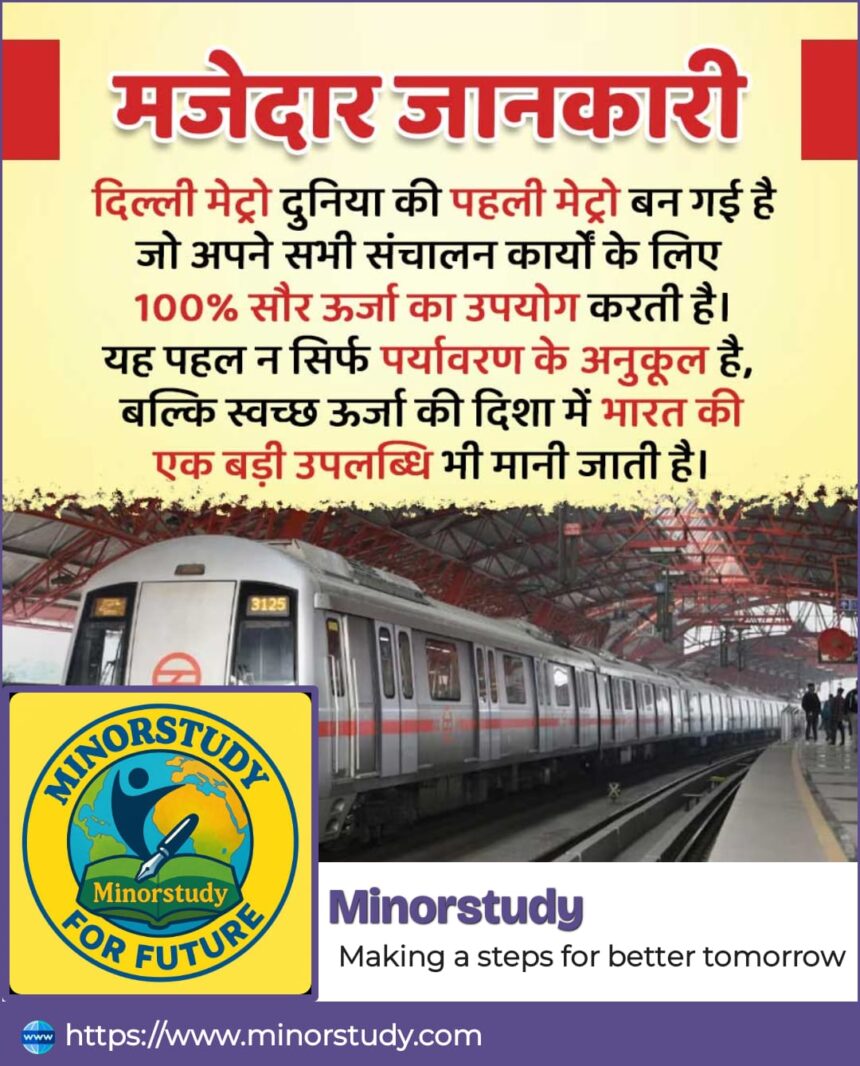🌞 Introduction: Delhi Metro’s Bold Solar Revolution
The Delhi Metro Rail Corporation (DMRC) has achieved a historic milestone by becoming the first metro system in the world to run its entire operations on 100% solar energy. This is not just a feat in engineering—it’s a monumental leap toward environmental sustainability and clean energy in urban transport.
- 📜 A Brief History of Delhi Metro’s Solar Journey
- 🌟 10 Powerful Facts About Delhi Metro’s Solar Energy Shift
- 📅 Timeline of Delhi Metro’s Clean Energy Evolution
- 🛤️ How Solar Energy Powers the Metro?
- 🔍 FAQs – Frequently Asked Questions
- 💡 Why Is This Important in Our Life?
- 🌍 1. Cleaner Air for Delhi
- ⚡ 2. Energy Independence
- 🌱 3. Environment Education
- 🏙️ 4. Urban Green Role Model
- 👨👩👧👦 5. Family-Friendly Transport
- 🌐 Significance in Society
- 🎯 Observances & Celebrations
- 📌 Important Points to Remember
- 💐 Wishing the Delhi Metro Team and Citizens
- 🧘♂️ Daily Life Impacts
- 🔚 Conclusion: A Bright Path Ahead
As urbanization surges, so does the need for clean and green infrastructure. In this regard, the Delhi Metro is a shining example, making India proud on the global green map.
📜 A Brief History of Delhi Metro’s Solar Journey
2002: Delhi Metro begins operations—initially using conventional electricity sources.
2014: DMRC signs agreement with Rewa Ultra Mega Solar Limited (RUMSL) in Madhya Pradesh to purchase solar power.
2017: Solar plants installed at various metro stations and depots.
2021: Solar power starts fulfilling more than 60% of operational energy needs.
2024: DMRC officially achieves 100% solar power operation for all stations, depots, and trains.
🌟 10 Powerful Facts About Delhi Metro’s Solar Energy Shift
World’s First: DMRC is the first metro system globally to transition entirely to solar power.
Massive Savings: Saves approximately Rs. 41 crore annually on energy costs.
Clean & Green: Helps reduce carbon emissions by over 2.5 lakh tonnes per year.
Power Partnership: Sources over 345 million units from Rewa Solar Power Project.
Net Zero Goal: Aligns with India’s Net Zero Emissions by 2070 vision.
Self-Sustaining: Solar panels installed on train depots, station rooftops, and parking lots.
Global Benchmark: Recognized by UN and international climate forums as a role model.
Green Certification: Over 35 metro stations certified as ‘Green Buildings’.
24×7 Power Reliability: Ensures uninterrupted service even during grid failure, with stored solar backup.
Public Impact: Over 30 lakh daily commuters now ride in environment-friendly trains.
📅 Timeline of Delhi Metro’s Clean Energy Evolution
| Year | Milestone |
|---|---|
| 2002 | First Delhi Metro line opens |
| 2014 | MoU signed with RUMSL for solar power supply |
| 2017 | Rooftop solar panels installed at stations |
| 2019 | 60% of energy from renewable sources |
| 2021 | Large-scale integration from Rewa Solar Plant begins |
| 2024 | Becomes 100% solar powered for all operational needs |
🛤️ How Solar Energy Powers the Metro?
Rewa Ultra Mega Solar Power Plant, Madhya Pradesh, is the backbone of DMRC’s solar supply.
Power is transmitted via Open Access Mechanism to Delhi.
Metro stations, escalators, lifts, lighting, and depot facilities are all solar powered.
Solar backup also ensures energy during peak loads or grid downtime.
Panels also generate additional rooftop power at 60+ metro locations.
🔍 FAQs – Frequently Asked Questions
Q1: Is the entire Delhi Metro network running on solar?
Yes, all operational energy needs including stations, depots, and trains are met via 100% solar power.
Q2: Who supplies the solar power to DMRC?
The Rewa Ultra Mega Solar Plant in Madhya Pradesh supplies the majority of the power.
Q3: How does it affect the ticket prices?
By saving on electricity bills, DMRC is able to manage costs efficiently, which can help stabilize or delay fare hikes.
Q4: How much carbon is saved by this move?
Annually, over 2.5 lakh tonnes of CO₂ emissions are avoided.
Q5: Can this model be applied to other Indian cities?
Yes. Metro systems in Mumbai, Bangalore, and Hyderabad are studying Delhi Metro’s model for replication.
💡 Why Is This Important in Our Life?
🌍 1. Cleaner Air for Delhi
In a city infamous for pollution, every initiative counts. Delhi Metro’s solar shift contributes to reducing air pollution significantly.
⚡ 2. Energy Independence
Relies less on the central electricity grid, leading to greater power stability and fewer outages.
🌱 3. Environment Education
It educates the public and inspires school children and youth to value sustainability.
🏙️ 4. Urban Green Role Model
The Delhi Metro stands as a replicable urban infrastructure model for other Indian and global cities.
👨👩👧👦 5. Family-Friendly Transport
Commuters—young, old, and families—can travel knowing they are not harming the planet.
🌐 Significance in Society
Global Prestige: Establishes India as a leader in clean transport solutions.
Boosts Green Jobs: Solar infrastructure and maintenance create employment opportunities.
Civic Awareness: Encourages citizens to adopt solar solutions in homes and businesses.
Innovation Booster: Promotes R&D in clean energy, batteries, and smart urban planning.
Supports SDGs: Aligns with UN’s Sustainable Development Goals (especially SDG 7 & 13).
🎯 Observances & Celebrations
While there’s no formal “Solar Metro Day” yet, awareness programs and school tours are frequently organized. Suggestions for future observances:
Green Metro Week: Featuring eco-activities for commuters and kids.
Solar Awareness Drives: At metro stations, with facts, demos, and competitions.
Public Rewards: Discounts or incentives for eco-friendly commuting habits.
📌 Important Points to Remember
Delhi Metro is the world’s first 100% solar powered metro.
Over 3 million passengers daily benefit from this green transition.
Over 60% of its power comes from Rewa Solar, and the rest from rooftops and auxiliary plants.
CO₂ emission reduction = taking 50,000 cars off the road annually.
Sets the standard for Indian urban sustainability.
💐 Wishing the Delhi Metro Team and Citizens
🌟 “Hearty congratulations to the Delhi Metro Rail Corporation and the people of Delhi for leading India into a sustainable future! May your journey be filled with clean energy, safe travels, and continued innovation. Let’s ride into a greener tomorrow—together!” 🌱
🧘♂️ Daily Life Impacts
| Area | Impact |
|---|---|
| Commuting | Safer, cleaner, quieter rides |
| Awareness | Citizens inspired to use renewable energy |
| Health | Better air quality improves public health |
| Affordability | Long-term savings can limit fare hikes |
| Education | A live model for environmental science and engineering |
🔚 Conclusion: A Bright Path Ahead
The Delhi Metro’s transition to 100% solar energy is not just a technological milestone—it’s a symbol of collective responsibility. It shows that with vision, planning, and political will, even the most energy-hungry systems can become environmentally sustainable.
As the climate crisis deepens, the Delhi Metro stands as a beacon of hope, reminding us that the power to change our future lies in clean choices made today.
🌞 Let this be not just Delhi’s achievement, but a call to all cities across India and the world. Green energy isn’t just possible—it’s powerful. 💚








